 Since Chelsea has asked: 'te haerenga' is Maori for 'the journey'; referring both to our extended working holiday visits to various places around the world and our journey through life. Sometimes we feel a little like these two at the end of a busy sight-seeing day.
Since Chelsea has asked: 'te haerenga' is Maori for 'the journey'; referring both to our extended working holiday visits to various places around the world and our journey through life. Sometimes we feel a little like these two at the end of a busy sight-seeing day.
Friday, May 04, 2007
Te Haerenga
 Since Chelsea has asked: 'te haerenga' is Maori for 'the journey'; referring both to our extended working holiday visits to various places around the world and our journey through life. Sometimes we feel a little like these two at the end of a busy sight-seeing day.
Since Chelsea has asked: 'te haerenga' is Maori for 'the journey'; referring both to our extended working holiday visits to various places around the world and our journey through life. Sometimes we feel a little like these two at the end of a busy sight-seeing day.
Tuesday, May 01, 2007
Wiltshire Wisteria - 29 April 2007
 On Sunday we visited a number of attractions around the very attractive town of Bradford-on-Avon.
On Sunday we visited a number of attractions around the very attractive town of Bradford-on-Avon.The first was Farleigh Hungerford, south of the town. After the unique experience (for us) of driving through a medieval gatehouse, just beyond a large moat (we could imagine the draw bridge) we toured the ruins of the Castle.
 All that remains intact is the priest house and Chapel complete with tombs, unique wall paintings and Crypt containing lead death masks on coffins of the lesser 16th and 17th century Hungerfords.
All that remains intact is the priest house and Chapel complete with tombs, unique wall paintings and Crypt containing lead death masks on coffins of the lesser 16th and 17th century Hungerfords.There were interesting stories about the castle, the one we found most interesting was the wife of the
 chief steward who murdered her husband and disposed of him in the large kitchen oven, so that she could then marry the Lord of the Manor.
chief steward who murdered her husband and disposed of him in the large kitchen oven, so that she could then marry the Lord of the Manor.Following this, we visited The Courts Gardens: they were bursting with new spring growth and colours; and we saw our first wisteria of the day, climbing up the house.
 Back into Bradford-on-Avon to visit the impressive Tithe Barn where the majority of the timber beams holding up the massive roof are 650 years old. Find a big oak with just the right bend and you have a ready-made arch-beam that will last for centuries!
Back into Bradford-on-Avon to visit the impressive Tithe Barn where the majority of the timber beams holding up the massive roof are 650 years old. Find a big oak with just the right bend and you have a ready-made arch-beam that will last for centuries! A pleasant walk along the River Avon took us into the town. Although much smaller than nearby Bath, it is still well worth a visit. A canal also flows though the town and we were able to enjoy the spring sunshine on a loop track along the river, and back via the canal.
A pleasant walk along the River Avon took us into the town. Although much smaller than nearby Bath, it is still well worth a visit. A canal also flows though the town and we were able to enjoy the spring sunshine on a loop track along the river, and back via the canal. By this time, Westwood Manor was due to open, so we headed south again. The earliest parts of this house date back to 983. The house is small, very liveable (still lived in by a tenant) and a fascinating time shot of history, having been restored in the early 20th century to be as it was in the 17th century. The garden has a topiary representation of the missing west wing.
By this time, Westwood Manor was due to open, so we headed south again. The earliest parts of this house date back to 983. The house is small, very liveable (still lived in by a tenant) and a fascinating time shot of history, having been restored in the early 20th century to be as it was in the 17th century. The garden has a topiary representation of the missing west wing.
Our final visit of the day was the best. The Peto Garden at Iford Manor is inspiring: once again, with a magnificent display of wisterias. The garden has been laid out in an Italian style. Colour, shapes, interesting layout, water features, pools, fountains, colonnades, it has it all. Not only is the garden wonderful, the position would be hard to beat.
 At the bottom of a sheltered valley, complete with a river flowing past the front gate and a picturesque bridge with a built-in seat nook.
At the bottom of a sheltered valley, complete with a river flowing past the front gate and a picturesque bridge with a built-in seat nook.The long spring day begged us to do one more walk on the way home, but despite thatched cottages and an disproportionately large, for the size of the village, Cathedral style church - we had been so visually over loaded at the Peto Garden that the walk based around the village
 of Bishops Canning was actually an anticlimax. But in fairness, it had quite the perfect ‘job description’ for a walk: past a beautiful church and thatched cottages, alongside rape fields in full bloom, across a grassy meadow, along a canal towpath, crossing back via a swing bridge and past a final thatched cottage to the start.
of Bishops Canning was actually an anticlimax. But in fairness, it had quite the perfect ‘job description’ for a walk: past a beautiful church and thatched cottages, alongside rape fields in full bloom, across a grassy meadow, along a canal towpath, crossing back via a swing bridge and past a final thatched cottage to the start.
Maud's Gift - 28 April 2007
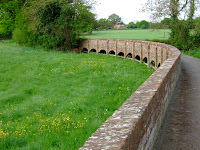 We had planned a weekend at Chippenham, and when reading up on the area, we were fascinated by the story of Maud Heath’s Causeway.
We had planned a weekend at Chippenham, and when reading up on the area, we were fascinated by the story of Maud Heath’s Causeway.After picking up a booklet about it from the Chippenham Information Centre, we set off to find the start. The causeway is 4½ miles long and Maud said she took an hour to reach the town. We cheated and drove for most of it, but walked the most interesting part with 64 arches.
 Maud spent her life walking across the low lying damp ground here, but today 530 years later; we enjoyed the very prestigious pathway that her legacy provided. On June 12, 1474 this remarkable woman made a gift of land, the income from which was to provide for the construction and maintenance of a causeway across the swampy ground. It is probably a unique instance of a grant by an individual for such a project and is even more intriguing in that the Trust has never been subsumed into any other body but continues to this day with the Trustees meeting at least once a year, as they have done with unbroken continuity since instigation.
Maud spent her life walking across the low lying damp ground here, but today 530 years later; we enjoyed the very prestigious pathway that her legacy provided. On June 12, 1474 this remarkable woman made a gift of land, the income from which was to provide for the construction and maintenance of a causeway across the swampy ground. It is probably a unique instance of a grant by an individual for such a project and is even more intriguing in that the Trust has never been subsumed into any other body but continues to this day with the Trustees meeting at least once a year, as they have done with unbroken continuity since instigation. On then to our next stop: Bowood House, where we only saw a very small portion of this lovely mansion. The formal terrace in front of the conservatory like wing is especially beautiful. The main reason for visiting Bowood, at this time of year, was to see their rhododendron garden.
On then to our next stop: Bowood House, where we only saw a very small portion of this lovely mansion. The formal terrace in front of the conservatory like wing is especially beautiful. The main reason for visiting Bowood, at this time of year, was to see their rhododendron garden.  This is over 60 acres, and it seemed we walked several miles following the various paths. The combination of rhododendrons and carpets of bluebells was especially beautiful but, in spite of our best efforts, seemed impossible to capture on camera.
This is over 60 acres, and it seemed we walked several miles following the various paths. The combination of rhododendrons and carpets of bluebells was especially beautiful but, in spite of our best efforts, seemed impossible to capture on camera. Our second feature visit of the day was Corsham Court, adjacent to the very picturesque village of Corsham. The core of the current building is over 400 years old but there are records of the Kings of Wessex having a summer palace here in 978. The wisteria here, as at Bowood, was in full bloom and stunningly beautiful.
Our second feature visit of the day was Corsham Court, adjacent to the very picturesque village of Corsham. The core of the current building is over 400 years old but there are records of the Kings of Wessex having a summer palace here in 978. The wisteria here, as at Bowood, was in full bloom and stunningly beautiful. We stopped at Ford for a very well presented meal at The White Hart pub, as recommended in our good pub guide.
We stopped at Ford for a very well presented meal at The White Hart pub, as recommended in our good pub guide.
Tuesday, April 24, 2007
A walk on the Wold side - 22 April 2007
 We started the day by driving back through Lincoln and heading for the Wolds. This is an area of attractive rolling countryside and we did a short walk between the villages of Tealby and Tealby Thorpe and back. Including the oldest thatched Pub in the county, Tealby has 22 listed buildings, including a school built by an uncle of Alfred Lord Tennyson. In this small village this means that one in every 8 buildings is listed.
We started the day by driving back through Lincoln and heading for the Wolds. This is an area of attractive rolling countryside and we did a short walk between the villages of Tealby and Tealby Thorpe and back. Including the oldest thatched Pub in the county, Tealby has 22 listed buildings, including a school built by an uncle of Alfred Lord Tennyson. In this small village this means that one in every 8 buildings is listed. A pleasant drive took us to Louth where Alfred Lord Tennyson went to school. It is a very lovely market town, with a stunning tall tower on the impressive church. It is quite a breathtaking vista as you round the corner on the road into town and see the church steeple dead ahead and framed by the buildings along the street. At 295 feet, it is the tallest Anglican parish church in the UK and, surprisingly, 25 feet taller than Lincoln Cathedral.
A pleasant drive took us to Louth where Alfred Lord Tennyson went to school. It is a very lovely market town, with a stunning tall tower on the impressive church. It is quite a breathtaking vista as you round the corner on the road into town and see the church steeple dead ahead and framed by the buildings along the street. At 295 feet, it is the tallest Anglican parish church in the UK and, surprisingly, 25 feet taller than Lincoln Cathedral. Alford was the next stop. This attractive town boasts a rare 5-sail windmill and the largest thatched manor house in England.
Alford was the next stop. This attractive town boasts a rare 5-sail windmill and the largest thatched manor house in England. Tattershall Castle is one of the many great finds in the middle of nowhere. Built in the 15th century, it has managed to survive thanks to the intervention of Lord Curzon who rescued and restored it early in the 20th century.
Tattershall Castle is one of the many great finds in the middle of nowhere. Built in the 15th century, it has managed to survive thanks to the intervention of Lord Curzon who rescued and restored it early in the 20th century.  As it was uninhabited from the middle ages, the castle has never been altered and modernised. Views from the top are stunning: the tower of Lincoln Cathedral to the northwest, and the Boston Stump to the southeast.
As it was uninhabited from the middle ages, the castle has never been altered and modernised. Views from the top are stunning: the tower of Lincoln Cathedral to the northwest, and the Boston Stump to the southeast. After lunch here, it was on to Boston. Here, in 1607 in the Guildhall the Pilgrim Fathers were imprisoned and tried for attempting illegal emigration. Later, they did sail for Holland and ultimately, in 1620, to “New England”.
After lunch here, it was on to Boston. Here, in 1607 in the Guildhall the Pilgrim Fathers were imprisoned and tried for attempting illegal emigration. Later, they did sail for Holland and ultimately, in 1620, to “New England”.North of Boston is the Sibsey Trader windmill. This stands six stories high and, when built, was the very latest in technology; the Rolls Royce of windmills, with its six sails.
 We were able to climb as high as the fifth floor, where we could observe the gears and machinery from behind the safety screens. They provide a teashop with cakes and bread baked from flour milled on the premises.
We were able to climb as high as the fifth floor, where we could observe the gears and machinery from behind the safety screens. They provide a teashop with cakes and bread baked from flour milled on the premises.Fortified by a sandwich made to order from their home baked bread,
 we set off to Spalding. The guidebook we consult 'Hidden Places of England' had a photo suggesting this area is full of fields of tulips. As tulips are in full bloom, we cruised the area known as South Holland, but although there are many fields of daffodils, tulips are now a thing of the past according to the information centre.
we set off to Spalding. The guidebook we consult 'Hidden Places of England' had a photo suggesting this area is full of fields of tulips. As tulips are in full bloom, we cruised the area known as South Holland, but although there are many fields of daffodils, tulips are now a thing of the past according to the information centre.Time for home, but as we happened to pass through Crowland
 we peered at the Abbey through the gate and were fascinated by the town’s Trinity Bridge over nothing. Once the place where a stream (long since dried up) divided, the bridge was cunningly designed to cross all the arms of the Y. This cute town obviously needs a proper visit when the Abbey is open.
we peered at the Abbey through the gate and were fascinated by the town’s Trinity Bridge over nothing. Once the place where a stream (long since dried up) divided, the bridge was cunningly designed to cross all the arms of the Y. This cute town obviously needs a proper visit when the Abbey is open.
The Pilgrim-age begins - 21 April 2006
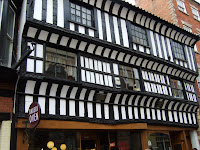 Lincoln is two hours from London and well worth the trip.
Lincoln is two hours from London and well worth the trip. We broke the journey at Newark-on-Trent to walk the Town Trail, before continuing on to Gainsborough to visit Gainsborough Old Hall. This is described as an unknown gem: one of the best-preserved timber framed manor houses in the UK.
We broke the journey at Newark-on-Trent to walk the Town Trail, before continuing on to Gainsborough to visit Gainsborough Old Hall. This is described as an unknown gem: one of the best-preserved timber framed manor houses in the UK. And it is an excellent little gem, (well, not that little really) well worth detouring to see. English Heritage has furnished it with authentic replica furniture and drapes, to give the feeling of the period. Begun around 1460, the Hall is huge, and visitors get to see a reasonable portion of it.
And it is an excellent little gem, (well, not that little really) well worth detouring to see. English Heritage has furnished it with authentic replica furniture and drapes, to give the feeling of the period. Begun around 1460, the Hall is huge, and visitors get to see a reasonable portion of it.Kings Richard III and Henry VIII have both stayed here, the Pilgrim Fathers worshipped in it before their journey to a new life in America and townsfolk gathered in the great hall to hear John Wesley preach.
 Lincoln was just down a brilliant straight Roman road.
Lincoln was just down a brilliant straight Roman road.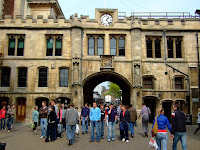 We loved Lincoln: the higher part of town is the Cathedral Quarter while at the bottom of the hill is the Cultural Quarter. Although we parked at the top by the Cathedral we had to hotfoot it to the bottom of
We loved Lincoln: the higher part of town is the Cathedral Quarter while at the bottom of the hill is the Cultural Quarter. Although we parked at the top by the Cathedral we had to hotfoot it to the bottom of  the hill to make it to the Guildhall for the 1:30 p.m. tour we had booked.
the hill to make it to the Guildhall for the 1:30 p.m. tour we had booked.The tour was most interesting, to see behind the scenes of Civic pomp, to see the original town charter, which predates the Magna Carta and also to learn about many of the old traditions they still follow from when Lincoln appointed its first mayor, 800 years ago.
We followed this tour with quick look at the new £13 million ‘Collection’ Museum. This is a fabulous modern building and the interior displays are very well done and most interesting.
 To get back to the Cathedral Quarter involved a walk up a street simply called ‘Steep Hill’, which lives up to its name. A cup of tea half way up kept us going before we visited the ruined remains of the Bishop's palace. Once again Henry VIII broke the wealth and power of the Bishops.
To get back to the Cathedral Quarter involved a walk up a street simply called ‘Steep Hill’, which lives up to its name. A cup of tea half way up kept us going before we visited the ruined remains of the Bishop's palace. Once again Henry VIII broke the wealth and power of the Bishops.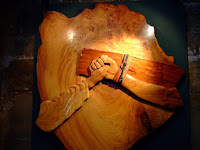 The final visit of the day was Lincoln Cathedral: what a statement of power. It is a magnificent building occupying a strategic position at the top of the hill. We particularly like the modern Stations of the Cross, done in various different timbers and aptly called ‘Forest Stations’.
The final visit of the day was Lincoln Cathedral: what a statement of power. It is a magnificent building occupying a strategic position at the top of the hill. We particularly like the modern Stations of the Cross, done in various different timbers and aptly called ‘Forest Stations’. It was also interesting to see the ‘frescos’ on the wall of the Chapter House that were put there for the filming of the Da Vinci Code. Lincoln Cathedral was used as the ‘body-double’ for Westminster Cathedral.
It was also interesting to see the ‘frescos’ on the wall of the Chapter House that were put there for the filming of the Da Vinci Code. Lincoln Cathedral was used as the ‘body-double’ for Westminster Cathedral.
Monday, April 16, 2007
Oxford - 15 April 2007
 Our two previous visits to Oxford have been on grey and misty days, so it was a real treat to see Oxford on a glorious, unseasonably warm, spring day.
Our two previous visits to Oxford have been on grey and misty days, so it was a real treat to see Oxford on a glorious, unseasonably warm, spring day.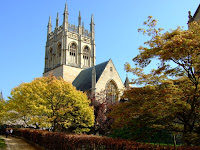 10 a.m. on a Sunday morning is a very peaceful time to start a walk around Oxford. We started with a free visit to Merton College then had a look around the recently revamped jail and castle complex.
10 a.m. on a Sunday morning is a very peaceful time to start a walk around Oxford. We started with a free visit to Merton College then had a look around the recently revamped jail and castle complex. By then our two hours free parking were up, so it was time to move on and play 'musical carparks’. We were fortunate to find another park on the other side of Oxford, and as it was Sunday we were entitled to another 2 free hours.
By then our two hours free parking were up, so it was time to move on and play 'musical carparks’. We were fortunate to find another park on the other side of Oxford, and as it was Sunday we were entitled to another 2 free hours. We used the time to visit New College and Trinity College. New College is, of course, anything but new. Its great hall is one of the oldest in Oxford and the front gate we entered through was hung 200 years before Columbus discovered America! Our return route to the car was via the Christ Church College meadows.
We used the time to visit New College and Trinity College. New College is, of course, anything but new. Its great hall is one of the oldest in Oxford and the front gate we entered through was hung 200 years before Columbus discovered America! Our return route to the car was via the Christ Church College meadows. Near Oxford is Rycote Chapel, one of the best-preserved chapels in Britain. It is unusual in that it was competed in one style and the structure has remained unchanged since being constructed in the 15th century and also it was not destroyed or defaced by Cromwell’s troops.
Near Oxford is Rycote Chapel, one of the best-preserved chapels in Britain. It is unusual in that it was competed in one style and the structure has remained unchanged since being constructed in the 15th century and also it was not destroyed or defaced by Cromwell’s troops. Inside it was modified to make a special covered pew for King Charles I, again very rare in the UK. Queen Elizabeth I also visited six times during her reign, as well as once when before becoming Queen when she was a prisoner of Mary and being held in custody in Woodstock.
Inside it was modified to make a special covered pew for King Charles I, again very rare in the UK. Queen Elizabeth I also visited six times during her reign, as well as once when before becoming Queen when she was a prisoner of Mary and being held in custody in Woodstock. The yew outside the church is reported to have been planted in 1137 but they can’t locate the gardener who planted it to confirm the date.
The yew outside the church is reported to have been planted in 1137 but they can’t locate the gardener who planted it to confirm the date.
Blossoms - 14 April 2007
 The Vale of Evesham is billed as one of the 4 best Blossom Trails in the world. As the weather forecast was excellent and we had accommodation booked in Oxford, we decided to fit the trail into our weekend.
The Vale of Evesham is billed as one of the 4 best Blossom Trails in the world. As the weather forecast was excellent and we had accommodation booked in Oxford, we decided to fit the trail into our weekend. This area has many old plum and apple orchards: the blossom was pretty much at its best, so we did enjoy the drive. As part of our total blossom experience we also did one of the ‘blossom trail’ walks.
This area has many old plum and apple orchards: the blossom was pretty much at its best, so we did enjoy the drive. As part of our total blossom experience we also did one of the ‘blossom trail’ walks. On the trail we passed though Pershore. It has a beautiful old medieval bridge with an excellent picnic spot, quite a rarity on British roads.
On the trail we passed though Pershore. It has a beautiful old medieval bridge with an excellent picnic spot, quite a rarity on British roads.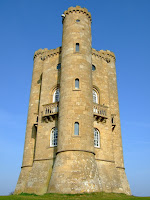
The final stop was a picture opportunity at the Broadway Tower. It could only be a picture stop as we arrived just after they had closed the Tower to visitors for the day.




Subscribe to:
Posts (Atom)



